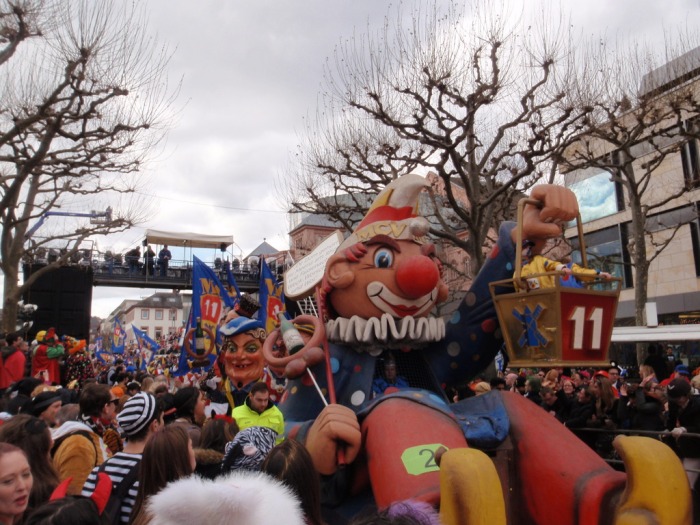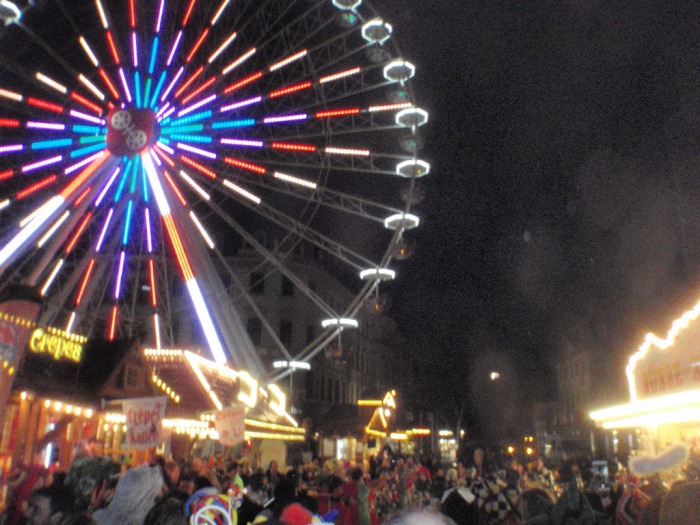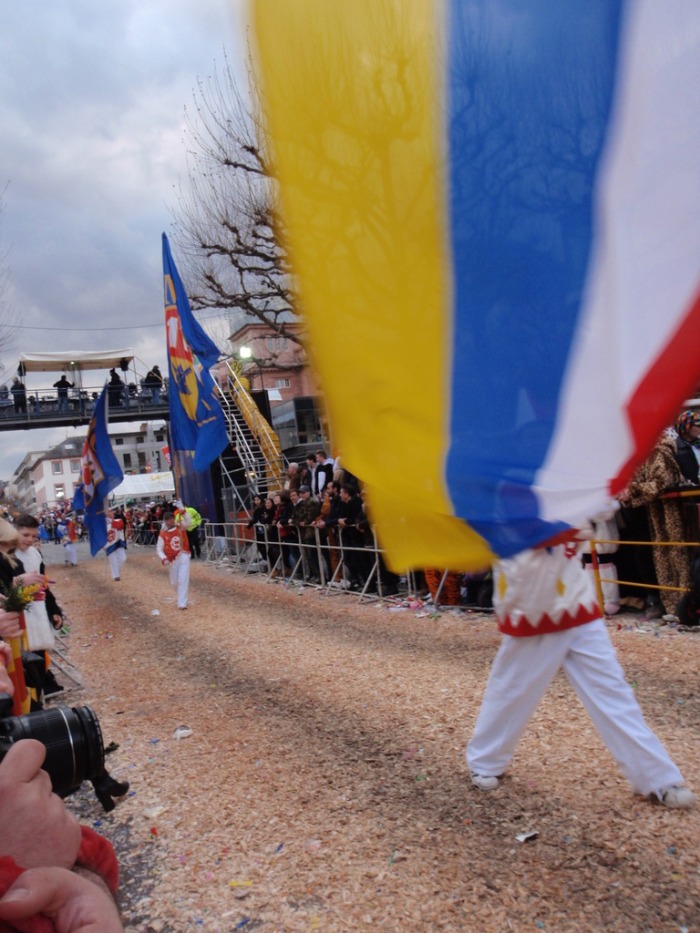

Johannisnacht (St. John’s Eve) is a time to celebrate the longest day of the year, the summer solstice. In Germany, of course, this calls for a festival. I thought it was a small festival being set up on the Mainz side of the Rhein River, but it turns out to be the biggest Fest I’ve ever seen so far. It outdoes the Christmas market in size, stretching along the Rhein in both directions from the Theodor-Heuss-Brücke (bridge) and spiraling into and through the Altstadt (old town). However, it only lasts for one long weekend. Here I describe this past weekend’s Mainzer Johannisnacht Fest – mostly with food – according to the alphabet.
Ananas und Apfel = Pineapple and apple. Here these fruits are covered in chocolate on a stick. If you don’t like either, you can also find chocolate-covered strawberries, bananas, grapes, melon, and other fruits.
Bratwurst. Typical fest food served with a roll or French fries.
Currywurst = Sliced Bratwurst drizzled with a curry ketchup-like sauce. This is also a very typical food and most commonly served with fries.


Dom = Cathedral. The Mainzer Dom at the heart of the Altstadt is surrounded by Biergarten areas, music, rides, games, and food stands during the Johannisnacht Fest.
Eis (pronounced “ice”) = Ice cream. Several stands brag of having “American ice cream.” This is also the first time in Germany that I’ve seen soft serve ice cream and slushies.
Fußball (ß means ss) = Soccer, Football. Because the World Cup is going on at the same time this year, just about every booth has a TV showing the games. On Saturday, Germany played Ghana and tied 2-2.

Glas = Glass. There aren’t many plastic cups here, so you pay a deposit of 2 Euros or so for a glass of beer, water, juice, or soda. When you return the glass, you get your deposit back. Erdbeerbowle, or strawberry punch, is the current seasonal drink and is usually available in a plastic cup at this Fest.

Herzen = Hearts. Gingerbread hearts with “Ich liebe dich” (I love you) and other cutesy phrases iced onto them fill many stands.

Imbiss = Snack. In addition to Bratwurst and fries, German Imbiss stands also sell snacks such as fresh-cut potato chips, fried potato pancakes with applesauce, Spätzle (noodles), cheeses, pickles, fried mushrooms, and a variety of small grilled meat dishes.
Jägermeister. A shot of this German herb-flavored liquor sells for a Euro.
Kunst = Art. Booths of jewelry, ceramics, paintings, wood carvings, and many more handmade crafts line the Rhein.

Literatur = Literature. One large spin-off area of the Fest houses a used book market and a printing booth that would make former Mainz resident Johannes Gutenberg proud.

Magenbrot. These small slices of iced spice cake, similar to gingerbread, are sold by weight in bags at the nuts and sweets stands.
Nüsse = Nuts. The nut stands define the smell of sweet and breathe deliciousness throughout the Fest. Almonds, cashews, peanuts, walnuts, pistachios, and more are roasted, candy-coated, and sold in cone-shaped bags. Coconuts (not actually nuts) are sold by the slice here too.

Orangensaft = Orange juice. Fresh squeezed, this is a refreshing Fest drink.
Popcorn. This is usually sold by the bag at the same stands as the nuts and other treats. It can be topped with salt, honey, chili, or chocolate.
Quintinsstraße = Quintin’s Street. One of the few streets in the old town area that the Fest doesn’t extend to. This is a good spot to take a break from the crowds.
Riesenrad = Ferris wheel. From here you can have a great view of the Rhein and the old town area of Mainz. And for about 60 Euros, you and five friends can drink sparkling wine and watch fireworks from a Riesenrad car on the last night of the Fest.

Schießen = Shooting. A popular game at many booths where you can use BB guns to shoot plastic flowers, metal shapes, and other targets for prizes. Other games include the claw machines, duck ponds, can pyramid knockdowns, and other standard carnival schemes.

Tanzmusik = Dance music. At least six stages of live music and a DJ booth provide entertainment with mostly American and some German rock & roll and pop music.
Ungarische Langos = Hungarian Langos (fried flat bread with sweet or savory toppings). These and other foreign foods are scattered throughout the fair amongst the more common German grills: Italian pizza, French crêpes, Spanish churros, U.S. beef, Thai noodles, and so on.
Volk (pronounced “folk”) = Folk, People. This is one crowded fest!
Wahrsagerin/Wahrsager = Fortune teller (literally, truth-sayer). In a few secretive booths, you can learn about your future.

XXL, IntoXX, und eXtreme Rutschen = The XXL takes riders around and around and upside down; the Intoxx is the swinging pirate ship; and the extreme slides provide a quick and bumpy ride to the bottom. Other rides throughout the fest include bumper cars, teacups, swings, merry-go-rounds and other kiddie rides, and many other rides that spin and twist.
YOLO = You Only Live Once. Yes, they have that expression in Germany too. It’s a good attitude for this summer Fest and it brings me to Z for…

Zuckerwatte = Cotton candy. The most classic of the street festival sweets is handspun and I found it the best way to end the Mainzer Johannisnacht Fest!













































































































